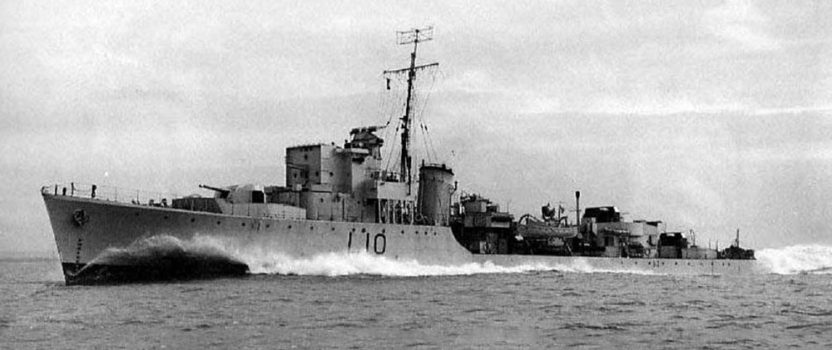The Deep Wrecks of Malta | HMS Southwold
HMS Southwold has been dived for some years but was brought under the protection of Heritage Malta’s Underwater Cultural Heritage Unit (UCHU) in May 2019 as a wreck of particular historical significance. As such, diving the ship is now only permitted when conducted by a select number of Malta and Gozo’s dive centres. You can find a full list of the dive centres at this link.

A diver inspecting one of the anti-aircraft gun turrets (Photo: John Wood/University of Malta)
HMS Southwold was a British Type II Hunt class destroyer which served for a short time with the Mediterranean Fleet before being sunk less than a year after her maiden voyage.
The Southwold was built by J. Samuel White and Company, a shipyard located at East Cowes on the Isle of Wight owned by a family with a shipbuilding history dating back to the mid-18th century. During the Second World War, the company specialised in building destroyers for the Royal Navy. HMS Southwold was ordered as part of the British War Emergency Programme, begun at the outbreak of the War in 1939 to build as much tonnage as possible to combat the Axis Fleet.
The Hunt class ships were a smaller form of ‘fast escort vessel’ or ‘escort destroyer’, smaller and less well-armed than the larger class of destroyers, of which 86 were built during the war. HMS Southwold was completed on 9 October 1941, 85m in length with a beam of 9.6m, armed with a total of 10 anti-aircraft guns, two 20mm cannon and carrying 110 depth charges.
The Southwold’s maiden voyage was to Scapa Flow, the main British Naval Base, for trials, after which she was deployed to join the Mediterranean Fleet, where, in January 1942, she joined the 5th Destroyer Flotilla.

Two of HMS Southwold’s anti-aircraft guns still in position (Photo: John Wood/University of Malta)
On 21 March 1942, HMS Southwold departed from the Egyptian port of Alexandria as part of an escort to four merchant ships bound for Malta. Four light cruisers and 17 other destroyers formed the rest of the convoy, along with the anti-aircraft cruiser HMS Carlise, which, six months earlier, had been part of the convoy escorting the SS Thistlegorm when it was attacked and sunk off the Sinai Peninsula.
The Southwold’s convoy came under heavy attack from the Italian navy the very next day, with two heavy cruisers, ten destroyers and a battleship waiting for the Allies in the Gulf of Sidra (also Sirte) off the coast of Libya. Heavily outgunned, the British laid down a smoke-screen to prevent the Italians from taking proper aim, and sailed in and out of the smoke firing at their superior opposition.
By the end of the day, the Second Battle of Sirte saw a wounded British convoy force the Italian Navy to retreat, although German bombers continued the attack, determined to stop the ships reaching Malta. Two of the merchant ships, the Talabot and Pampas made it to Valetta but a third, the Clan Campbell was sunk 20 miles from the harbour, with the loss of ten lives.

(Photo: John Wood/University of Malta)
On the 23 March, the oil tanker Breconshire, the fourth of the merchant ships, was hit by German bombs and forced to stop a few miles from Malta. On the following day, the crew of the HMS Southwold, ordered to tow the Breconshire to port, were attempting to pass a line to the disabled ship when the Southwold struck a mine that exploded underneath her engine room. One officer and four crewmen were killed in the explosion.
An attempt was made to tow the Southwold to Valetta harbour but the structural damage was too great. On 24 March 1941, the hull split in two and the HMS Southwold sank, approximately 1.5miles (2.4km) from Marsaskala Bay, Malta.
Today, the wreck of the Southwold lies in two sections approximately 300 metres apart. The bow is the largest section, approximately 40m in length and lying on its starboard side at a depth of around 70m. The stern section is approximately 28m long and lies upright in 72m water. Although attempts were made to salvage the ship, divers should still be wary of unexploded ordinance that can be found in the wreckage.
www.visitmalta.com/en/info/southwold
The wrecks featured in this series have been declared to be Archaeological Zones in the Sea by the Cultural Heritage Act of Maltese law, and it must be remembered that most are also war graves. As such, the wrecks can only be dived through dive centres approved and registered with the Underwater Cultural Heritage Unit of Heritage Malta, and protective measures to prevent unauthorised diving are strictly enforced. For more information, the original UCHU reports and a complete list of approved dive operators, visit the Heritage Malta Historic Wreck pages at www.visitmalta.com.
By Mark ‘Crowley’ Russell – Dive UK Magazine


